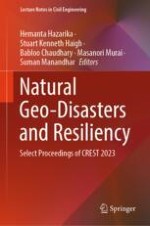2024 | OriginalPaper | Buchkapitel
Characteristics of Debris Flow that Crosses Bhutan’s Mountain Roads and Its Countermeasures
verfasst von : Tomohiro Nishimura, Kiyoharu Hirota, Tomoharu Iwasaki
Erschienen in: Natural Geo-Disasters and Resiliency
Verlag: Springer Nature Singapore
Aktivieren Sie unsere intelligente Suche, um passende Fachinhalte oder Patente zu finden.
Wählen Sie Textabschnitte aus um mit Künstlicher Intelligenz passenden Patente zu finden. powered by
Markieren Sie Textabschnitte, um KI-gestützt weitere passende Inhalte zu finden. powered by
